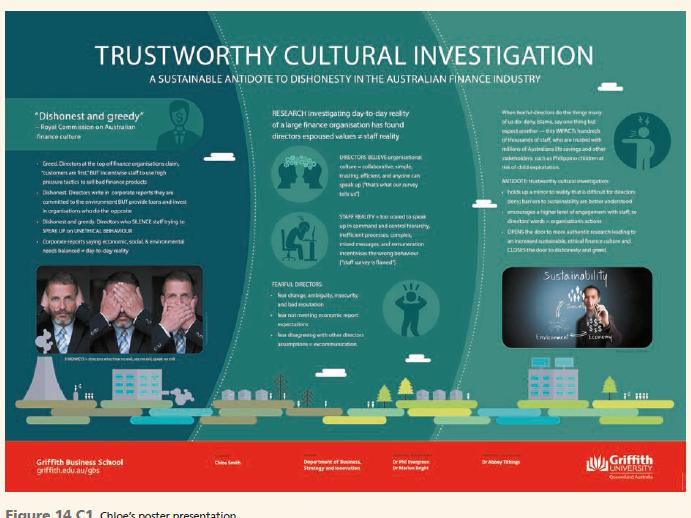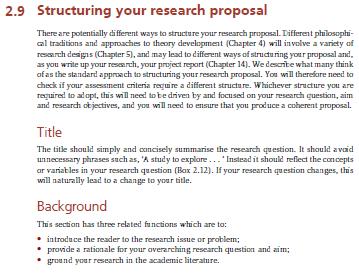It was the start of the new year and Chloe had taken a leap of faith, leaving
Question:
It was the start of the new year and Chloe had taken a leap of faith, leaving her full- time job to complete a master's degree. Now, with her research project, she was addressing her long-standing desire to study corporate sustainability in finance. A an investor relations officer she had seen first-hand 'dishonest and greedy' finance culture, and as a volunteer for the home- less she had also seen the very real world impacts of corporate greed (Hayne 2018: 73). Her industry contacts had opened the door to her interviewing participants in a large finance organisation where she had access to all hierarchical subcultures; this access meant rich data could be collected for her interpretive case study (Schein and Schein 2019; Yin 2018). In preparation for her research project, Chloe developed a timeline capturing study tasks, part-time work and her sister's wedding, which coincided with the end of her programme. The task of writing and re-writing the project report was a given, but a poster and video presentation was outside her comfort zone. Chloe re-adjusted her timeline to allow more space. The poster and presentation were crucial to achieving a good grade for the master's degree. Reflecting on what study tasks needed to be done Chloe began to think about how she would prepare for the poster presentation; as an introvert she knew she became stressed if she left everything to the last minute. Chloe resolved to prioritise the poster work. The time to make a start on the structure was now: almost immediately she felt like 'procrastibaking' (procrastinating via baking). Instead she carried on, reading business research methods textbooks and watching YouTube clips on academic poster presentations (American Journal Experts 2016; Morrison 2019). A key corroborating theme was the need to take people on a research journey; even a poster has a start, middle, and end. Another theme was understanding your target audience who are often time poor, or suffering cognitive overload; so, the use of clear space and images were advised to make it easy to view, avoiding academic jargon was also advised. Knowing she would need to write many iterations of her poster presentation and allow time for reflection, Chloe wrote her first attempt early, setting a limit of 300 words. Despite her best efforts it was 500 words and did not flow well; however, it was a start and the outline of three poster panels were emerging:

Excitement was building as the poster/research was taking shape. Chloe decided to try out her presentation with her dinner guests, sticking to the three-minute time limit. Fortunately, the food was good, because the presentation needed considerably more work. Themes, although clear in her mind, were difficult for her guests to understand. One suggested she try practising the presentation using more of her own words. Another paid her a compliment on keeping to three minutes. Taking on board the constructive criticism, Chloe finessed her presentation further and re-read her findings chapter (Cunliffe 2011). Her increased clarity helped conceptualise the types of images needed to illustrate her poster. Chloe searched her phone and the Web for potential images, eventually purchasing two stock images online. Next, she presented the updated version to her supervisors. Their feedback was helpful: 'Be bolder in outlining the issues and avoid using organisational development and corporate sustainability academic jargon to better connect with a broader audience.' Chloe continued revising the text on the poster and repositioning and resizing the images. During this time, she also practised the presentation using the video camera on her phone. After each practice run of the poster presentation, she would watch it back, reflecting on whether it made sense, or if a different word/phrase should be used or removed. In addition to improving the presentation script, the video practice highlighted recording environment considerations such as lighting and sound. Some conditions she could alter, others not. On the day of filming the video, things did not initially go as anticipated. Chloe forgot parts of her script, spoke for too long, and there were also unexpected shadows and noises such as an aeroplane flying over. When she started to feel the video would not be completed, she took a break. As she sipped on her tea and meditated in the garden, she recalled what she'd given up to do this master's. Persistence, not perfection, was needed now; she had to submit tomorrow.

Questions
1 What personal strengths, weaknesses and other factors impacted Chloe’s ability to complete the poster presentation?
2 What personal strengths, weaknesses and other factors are impacting your ability to complete your poster presentation? What have you (or others) sacrificed to undertake this study?
3 What practical tips did Chloe consider in the development of the poster and presentation?
4 a Have you written a timeline to ensure your timely master’s completion, allowing for various iterations of your poster and presentation???? If not, revisit Section 2.9, and in particular the section on ‘Timescales’ and construct a Gantt chart outlining the tasks you need to do.
b When viewing Chloe’s poster can you identify an image/s aligned to her start, middle, and end as well as key points?

Step by Step Answer:

Research Methods For Business Students
ISBN: 9781292402727
9th Edition
Authors: Mark Saunders, Philip Lewis, Adrian Thornhill





